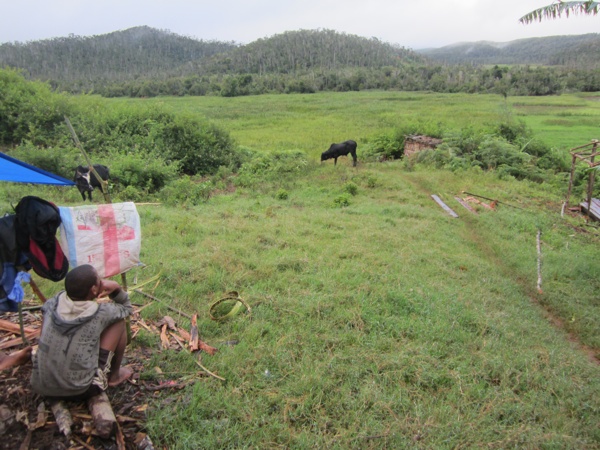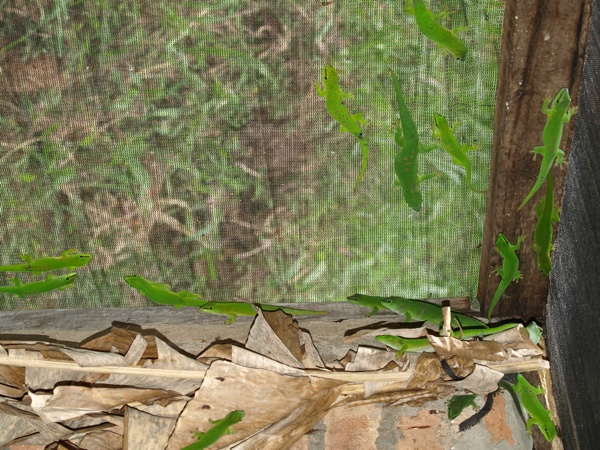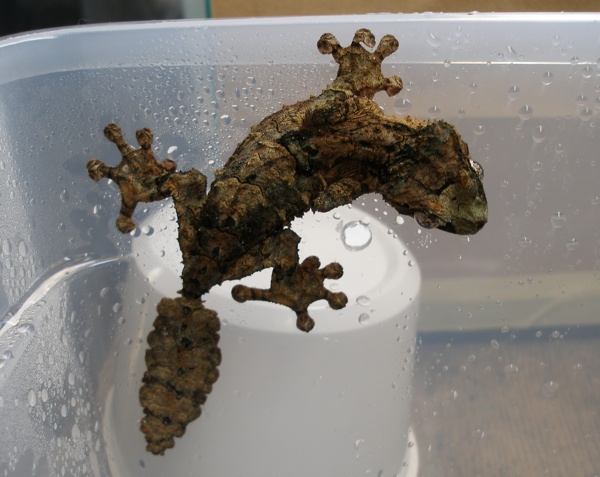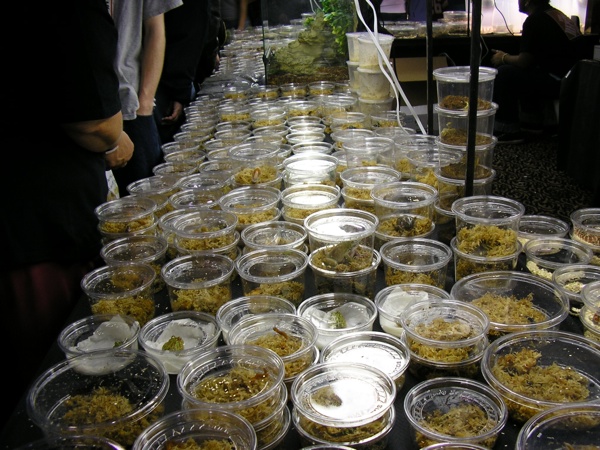Ragasy and I walked through shin-deep mud, following an old logging road between forests and mist-covered hills. We were near the town of Fierenana, where many of Madagascar’s wild-caught herps originate, such as Uroplatus pietschmanni and Paroedura masobe.
In the Field
“How much does he pay you for each animal?” I asked Ragasy. “He” referred to a man named Fidel, who was one of several middlemen in a chain of command that stretched from the retail pet stores in the States to Ragasy in Fierenana.
“Well, it depends on the type. For Mantella, we used to get 200 Ariary per frog, but now the laws have changed and he does not ask us for these frogs anymore.” This equated to about 9 cents per individual, a species which abroad would sell for more than $50 retail. “For Dyscophus we get less.” He added.
After Ragasy would collect enough, Fidel would take them to the nearest city where they would then be sent to the capital of Madagascar, Antananarivo, to be held in a warehouse until being flown to the States. The owners of this holding facility and the importers and retailers in the US would profit. Ragasy would get a little bonus for the day, then back to mining gold and growing rice.

The journey to the States could result in high rates of mortality should something go wrong (see this recent South African news story http://www.iol.co.za/dailynews/news/exotic-animal-export-a-massacre-1.1639761#.UuxlLRCSw7r for the worst case scenario) At best, importers factor in a ten percent loss on orders to be safe.
The Truth about Wild-Caught
“Is the money from collecting reptiles and amphibians an incentive to preserve the forest?” I asked. Ragasy just looked at me. He didn’t understand. I tried asking again in a different way, my Malagasy still only up to par with that of a four year old. He still didn’t understand.

I explained the question in English to the Malagasy student from the University who was along with us on this research trip and he asked Ragasy one last time. Ragasy laughed and told us people will always need to grow rice and cut down trees, and that it’s the local community group that patrols the forest that is responsible to protect it.
Money made from collecting herps was not reason enough to protect their habitat, one of the common justifications the hobby provides in support of maintaining field collected stock.
Opposite Ragasy in the trade, on the other side of the long chain which can take months for an individual animal to travel, is the hobbyist, the end destination for the wild-caught reptiles and amphibians that leave Madagascar by the thousands annually.
We (hobbyists) like to rationalize the wild-caught trade. Dialogue at herp shows and online on forums often follows a predictable path where collectors are excited for the newest species “fresh off the boat”.
At best, WC animals are the elephant in the room, the truth that is plain to see but yet which hobbyists are not prepared to have an honest conversation about.
But, it should be possible to change this attitude within the community.

What to Do?
- Always buy captive-bred animals when available. Yes, there may be a long wait list, and yes they may be more expensive than their wild-caught counterparts, but be patient and sensible. If the species is available CB, go this route. Always.
- Look into the natural history of the taxa you wish to keep. If a species is not available CB, investigate its origins. Where does it come from? How does it live? Is it a threatened species?
- “Legal” does not equate with “ethical”. Species on the verge of extinction and those that are only very recently discovered are collected from the wild and legally sold on a regular basis. If the species you want to keep is just a little tiny red dot on a map of its distribution, skip it for something else.
- Captive breeding rarely contributes to conservation. The greatest myth is that the reptiles and amphibians we keep in glass boxes somehow contribute to the protection or conservation of the species. This simply is not the case. Buying wild-caught rare or threatened species does nothing to aid their plight in the wild, and if anything may contribute to their decline or extinction.



I commented on this article on FB but thought it was prudent to post it here as well…
“Money made from collecting herps was not reason enough to protect their habitat, one of the common justifications the hobby provides in support of maintaining field collected stock.”
I found this comment interesting. I don’t know of anyone who thinks that in it’s current state, the collection and sale of these species equates to conservation. I know many of us who believe it CAN equate to conservation but so much more is required to get it going in that direction. It would require a change in culture from the collectors, exporters, importers and the hobbyist alike. Also, I don’t believe the hobby is the root cause of Madagascar declining wildlife, rather, deforestation is. Malagasy folks cut down the forests for many reasons! Charcoal is used to heat their homes (if you can call them that), or to raise palm tree for the palm oil industry, amongst many other reasons. If anything, I’d rather them collect and ship out all they can from a patch of forest that is to be razed. At least some of them would have a chance IMO.
I must say thank you for this excellent article! This was by far the most honest look at the export/import trade I’ve ever seen in print within the hobby. In my opinion, this short article would never have been published in any of the larger herp magazines due to a direct conflict of interest. It is a very sad truth hat our hobby is founded on the backs of mistreated field collected herps – many of which die before their first year in captivity. The ones that do survive are likely to, as your title suggests, end up in a shoe box, or some other unstimulating or incorrect habitat. It saddens my heart deeply when I think of this.
That being said, if one of my dream species comes in, I will be snatching them up to make sure that at least a few of these poor animals make it into good hands and to preserve them in the hobby. Again, I am speaking only of keeping them in the hobby once collection ceases. In agreement with your statement above, any hobbyist that thinks them setting up a small captive breeding program for the pet trade is going to help wild conservation is simply out to lunch.
If we could eliminate everything but low volume, responsible hand collecting (solely for the introduction of new species into the hobby) – and make those animals more expensive than captive bred ones, I feel both the hobby and nature would benefit. A pipe dream, but a dream none the less!
Anyways, thank you again for the excellent article and good luck with your efforts in Madagascar!
I’m in total agreement with Mr. Cantrell-very informative article.
Every single species you enjoy in captivity started with wild caught stock.
If you want to be upset about it, regulate it.
I’ve been thinking this since I was young, and after I got introduced into the gecko hobby. I had the exact same thoughts as you.
I’m not able to sustain many individuals, so I couldn’t go further than the common species of the market.
But still, if I wanted a rarer one, I wouldn’t buy a WC animal for the above reasons, plus they may arrive in poor health.
But the biggest part that keeps me away from obtaining WC geckos is the ethical part.
I couldn’t agree more with this article. Keep up the good work!
Even if it’s cheaper wc if you end up having to make a vet visit (which is more than likely) then you’ll be spending the same amount you would’ve on a CB anyway!